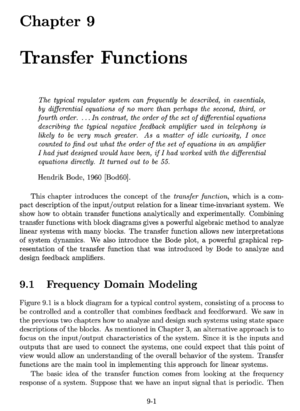Difference between revisions of "Transfer Functions"
Jump to navigation
Jump to search
(Created page with "{{Chapter |Chapter number=9 |Previous chapter=Output Feedback |Next chapter=Frequency Domain Analysis }}") |
Tag: Undo |
||
| (7 intermediate revisions by the same user not shown) | |||
| Line 1: | Line 1: | ||
{{Chapter | {{Chapter | ||
|Chapter number=9 | |Chapter number=9 | ||
| + | |Short name=xferfcns | ||
|Previous chapter=Output Feedback | |Previous chapter=Output Feedback | ||
|Next chapter=Frequency Domain Analysis | |Next chapter=Frequency Domain Analysis | ||
| + | |First edition URL=https://www.cds.caltech.edu/~murray/amwiki/index.php?title=Transfer_Functions#Frequently_Asked_Questions | ||
| + | |Chapter summary=This chapter introduces the concept of the transfer function, which is a com- pact description of the input/output relation for a linear time-invariant system. We show how to obtain transfer functions analytically and experimentally. Combining transfer functions with block diagrams gives a powerful algebraic method to analyze linear systems with many blocks. The transfer function allows new interpretations of system dynamics. We also introduce the Bode plot, a powerful graphical rep- resentation of the transfer function that was introduced by Bode to analyze and design feedback amplifiers. | ||
| + | |Chapter contents=# The Loop Transfer Function | ||
| + | # The Nyquist Criterion | ||
| + | #* The Nyquist Plot | ||
| + | #* The General Nyquist Criterion | ||
| + | #* Conditional Stability | ||
| + | # Stability Margins | ||
| + | # Bode's Relations and Minimum Phase Systems | ||
| + | # Generalized Notions of Gain and Phase | ||
| + | #* System Gain and Passivity | ||
| + | #* Extensions of the Nyquist Criterion | ||
| + | #* Describing Functions | ||
| + | # Further Reading | ||
| + | :: Exercises | ||
}} | }} | ||
Latest revision as of 16:36, 24 November 2024
| Prev: Output Feedback | Chapter 9 - Transfer Functions | Next: Frequency Domain Analysis |
This chapter introduces the concept of the transfer function, which is a com- pact description of the input/output relation for a linear time-invariant system. We show how to obtain transfer functions analytically and experimentally. Combining transfer functions with block diagrams gives a powerful algebraic method to analyze linear systems with many blocks. The transfer function allows new interpretations of system dynamics. We also introduce the Bode plot, a powerful graphical rep- resentation of the transfer function that was introduced by Bode to analyze and design feedback amplifiers.
Contents
- The Loop Transfer Function
- The Nyquist Criterion
- The Nyquist Plot
- The General Nyquist Criterion
- Conditional Stability
- Stability Margins
- Bode's Relations and Minimum Phase Systems
- Generalized Notions of Gain and Phase
- System Gain and Passivity
- Extensions of the Nyquist Criterion
- Describing Functions
- Further Reading
- Exercises
